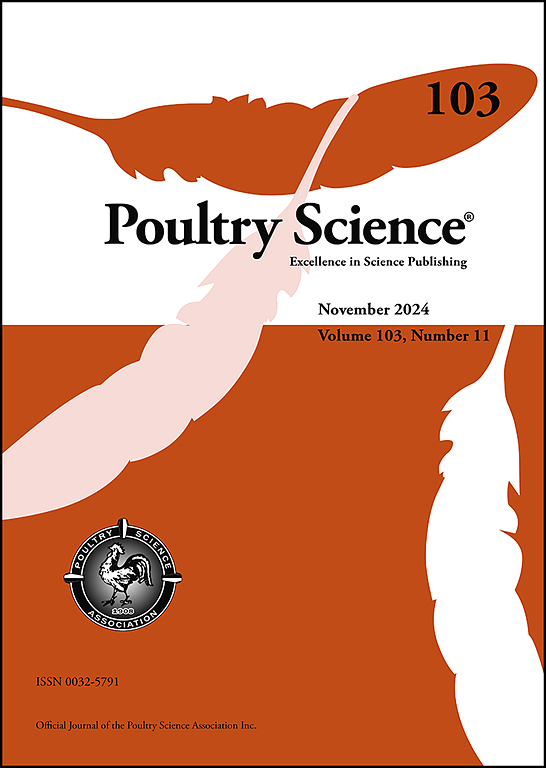Research note: Complex evaluation of whole oats and dehulled oats as feedstuffs for broiler chickens
IF 3.8
1区 农林科学
Q1 AGRICULTURE, DAIRY & ANIMAL SCIENCE
引用次数: 0
Abstract
This study aimed to gain a better understanding of how the structural and viscous fibers of oats can affect the performance, some selected blood interleukins, short chain fatty acid content and microbiota composition of the ceca of broiler chickens. A floor pen trial was carried out with 576 Ross 308 broiler cockerels. Aside from a corn–soybean-based control diet (C), the two other treatments contained either 10, 10 and 20 % whole oats (WO) or dehulled oats (DO) in the starter, grower and finisher phases respectively. The diets were isocaloric and isonitrogenous, differing only in their structural and soluble fiber and fat content. DO diets resulted in significantly higher weight gain compared with the two other treatments. The best feed conversion ratio (FCR) was also measured in the DO treatment group. The higher fiber content of WO diets did not compromise the production traits in comparison with the control diet. DO treatment resulted in increased interleukin-1beta (IL-1β), whereas WO decreased interleukin-8 (IL-8) concentration of the blood serum at day 39. Both oat treatments reduced the abundance of lactic acid-producing genera, the acetate, butyrate and the total short chain fatty acid (SCFA) content in the ceca.
研究说明:全燕麦和去皮燕麦作为肉鸡饲料的综合评价
本研究旨在更好地了解燕麦结构纤维和粘性纤维对肉鸡生产性能、部分选定血液白细胞介素、短链脂肪酸含量和盲肠微生物群组成的影响。以576只罗斯308肉用公鸡为试验对象,进行了地面栏试验。除了以玉米-大豆为基础的对照饲粮(C)外,另外两种处理分别在发酵期、生长期和育成期添加10%、10%和20%的全燕麦(WO)或去皮燕麦(DO)。这些饮食都是等热量和等氮的,不同之处在于它们的结构和可溶性纤维和脂肪含量。与其他两种治疗方法相比,DO饮食导致体重增加显著增加。同时测定了DO处理组的最佳饲料系数(FCR)。与对照饲粮相比,高纤维含量的低氮饲粮不影响生产性状。在第39天,DO治疗导致白细胞介素-1β (IL-1β)升高,而WO降低了血清白细胞介素-8 (IL-8)浓度。两种燕麦处理均降低了产乳酸菌的丰度,降低了盲肠中乙酸、丁酸和总短链脂肪酸(SCFA)含量。
本文章由计算机程序翻译,如有差异,请以英文原文为准。
求助全文
约1分钟内获得全文
求助全文
来源期刊

Poultry Science
农林科学-奶制品与动物科学
CiteScore
7.60
自引率
15.90%
发文量
0
审稿时长
94 days
期刊介绍:
First self-published in 1921, Poultry Science is an internationally renowned monthly journal, known as the authoritative source for a broad range of poultry information and high-caliber research. The journal plays a pivotal role in the dissemination of preeminent poultry-related knowledge across all disciplines. As of January 2020, Poultry Science will become an Open Access journal with no subscription charges, meaning authors who publish here can make their research immediately, permanently, and freely accessible worldwide while retaining copyright to their work. Papers submitted for publication after October 1, 2019 will be published as Open Access papers.
An international journal, Poultry Science publishes original papers, research notes, symposium papers, and reviews of basic science as applied to poultry. This authoritative source of poultry information is consistently ranked by ISI Impact Factor as one of the top 10 agriculture, dairy and animal science journals to deliver high-caliber research. Currently it is the highest-ranked (by Impact Factor and Eigenfactor) journal dedicated to publishing poultry research. Subject areas include breeding, genetics, education, production, management, environment, health, behavior, welfare, immunology, molecular biology, metabolism, nutrition, physiology, reproduction, processing, and products.
 求助内容:
求助内容: 应助结果提醒方式:
应助结果提醒方式:


